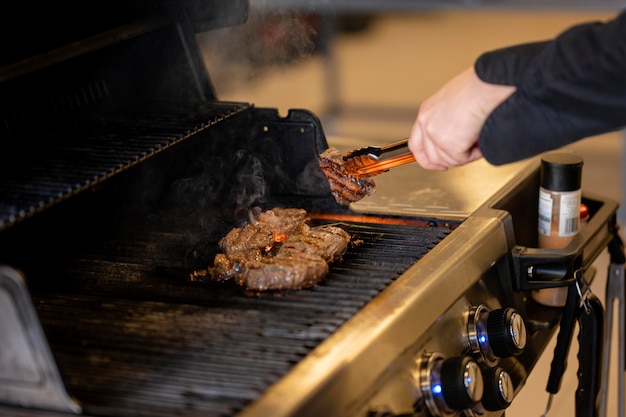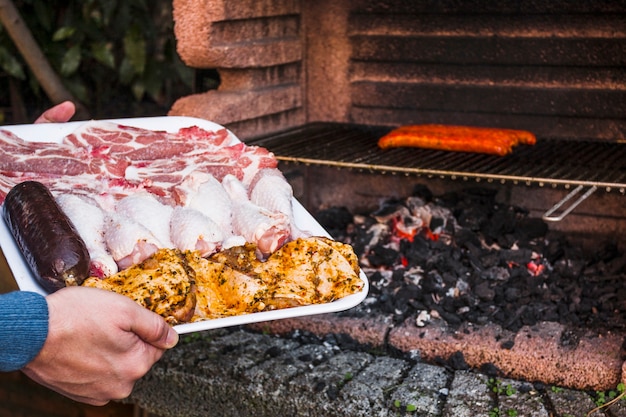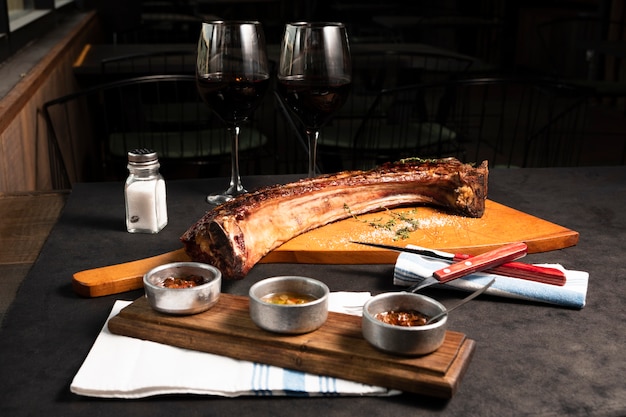(Part 1) The Rib Rundown: Choosing Your Cut

baby back ribs
Baby back ribs are the crowd-pleaser, often considered the "gold standard" of ribs. They're generally smaller than spare ribs, boasting a more compact bone structure and a higher proportion of meat. This translates into quicker cooking times and a naturally more tender outcome. They also have a slightly milder flavour, making them a good choice for those who prefer their ribs on the subtler side.
Spare Ribs
Spare ribs, on the other hand, are the brawny, flavourful choice. They're larger, with a thicker layer of fat that adds a richer, more intense flavour and helps keep the meat moist during the lengthy cook. However, they require more time and attention to reach that melt-in-your-mouth tenderness.
Personally, I'm a big fan of both. Baby backs are my go-to for a quick weeknight meal, while spare ribs are perfect for a leisurely weekend barbecue where everyone can linger around the smoker and soak up the smoky aroma. Ultimately, it's a matter of personal preference and what you're looking for in your rib experience.
(Part 2) Getting Ready: Prepping Your Ribs

1. Cleaning the Ribs
First things first, give those ribs a good clean. You'll want to remove any loose membrane from the back of the ribs. This tough, white membrane, often called the "silver skin," can make the ribs tough and chewy. You can use a paper towel to carefully peel it off, or for a more secure grip, use a butter knife to help you get a good hold. Don't worry, this step is easier than it sounds!
2. Trimming Excess Fat
Next, trim away any excess fat. We're not aiming to remove all the fat – that's flavour, folks! But we want to trim any large chunks of fat, especially those hanging over the edges. This helps the ribs cook more evenly and prevents flare-ups in the smoker, which can lead to burnt bits and an unpleasant smoky taste.
3. Applying the Rub
Now comes the fun part: applying the rub. This is where you bring the flavour party to life! A good rib rub is a symphony of spices, usually a blend of paprika, cumin, garlic powder, onion powder, salt, pepper, and more. You can buy pre-made rubs, which offer a great starting point, or create your own custom blend to unleash your inner spice enthusiast.
When applying the rub, make sure to cover every surface of the ribs. You want those spices to penetrate the meat and create a flavorful crust that'll make you drool just looking at them. Don't be shy with the rub! A good, generous coating is key to locking in that flavour.
I love to use a wet rub on my ribs, which involves adding a touch of liquid like mustard or apple cider vinegar to help the spices stick better. This creates a sticky base for the dry rub to adhere to, ensuring a more even coating and a more robust flavour.
(Part 3) Setting the Stage: Choosing Your Smoker

1. offset smokers
Offset smokers, also known as horizontal smokers, are the classic choice for barbecue enthusiasts. They feature a large firebox offset from the main cooking chamber, creating indirect heat that's ideal for low and slow smoking. Their larger size makes them perfect for big gatherings, where you can smoke enough ribs to feed an army of hungry barbecue lovers.
2. pellet grills
Pellet grills are gaining popularity thanks to their user-friendliness and consistently delicious results. They use wood pellets as fuel, which add a delicious smoky flavour to your ribs, while offering precise temperature control for a more hands-off approach to smoking.
3. electric smokers
Electric smokers offer a convenient and temperature-controlled option, especially for those who want a more hands-off experience. They are generally smaller than other types, making them suitable for smaller portions or for those with limited space.
Ultimately, the best smoker for you will depend on your personal needs and preferences. I personally have an offset smoker that I use for my big barbecue gatherings, and I also have a pellet grill that I use for smaller smokes. The beauty of smoking ribs is that there's a smoker out there for every taste and need.
(Part 4) Firing Up the Smoker: Setting the Temperature
You've got your ribs, your rub, and your smoker – now it's time to fire it up! For smoking ribs, you want to maintain a low and slow temperature, usually between 225°F and 250°F. This gentle heat allows the meat to cook slowly and evenly, resulting in tender, flavorful ribs with a beautifully rendered bark.1. Choosing Your Fuel
First, you need to decide what kind of fuel you'll use. For offset smokers, you can use charcoal, wood chunks, or a combination of both. For pellet grills, you'll use wood pellets. Each fuel option offers a different flavour profile, so choose one that complements your desired taste. For example, hickory wood is a classic choice for a robust, smoky flavour, while cherry wood provides a sweeter, more delicate touch.
2. Monitoring the Temperature
Once your smoker is fired up and you've reached your desired temperature, you'll need to monitor it closely. Use a meat thermometer to ensure the temperature stays consistent throughout the cook. You can also use a thermometer with an alarm, which will alert you if the temperature drops too low, preventing uneven cooking and potentially drying out the ribs.
(Part 5) Getting Smoky: The Low and Slow Cook
The moment of truth has arrived – time to get those ribs in the smoker and let them work their magic!1. Placing the Ribs in the Smoker
Place the ribs in the smoker with enough space between them so that the heat can circulate evenly. You can cook them on a rack or directly on the smoker's grate, depending on your smoker and your preference.
2. The "smoke ring" Mystery
You've probably heard about the "smoke ring" – that pink band that forms around the edge of the meat during smoking. It's a visual indication of the presence of smoke, and while it's not necessarily a guarantee of flavour, it's definitely a beautiful thing to see. To get that smoke ring, you need to maintain a low and slow temperature and ensure there's enough smoke in the smoker.
3. Adding Water to the Smoker
Adding a water pan to your smoker can help to keep the humidity levels high, which is essential for tender ribs. The water also helps to prevent the meat from drying out and creates a more consistent temperature, preventing hot spots in the smoker that can lead to uneven cooking. I usually add a pan of water to my smoker about halfway through the cook.
4. Wrap It Up: The "Stall" and the "texas crutch"
Now, here's where things get interesting – the "stall." The stall is a phenomenon that happens during the cooking process where the temperature of the ribs plateaus for a while. This is perfectly normal, and it's caused by the evaporation of moisture. To overcome the stall, you can wrap the ribs in foil. This technique, often called the "Texas Crutch," helps to trap steam and accelerate the cooking process. Wrapping also helps the ribs become more tender and juicy, creating that melt-in-your-mouth texture we all crave.
I usually wrap my ribs in foil around the 3-hour mark, depending on the size of the ribs and the temperature of the smoker. You can use aluminum foil or butcher paper – both work well. Experiment with both methods to see which you prefer.
5. Keeping an Eye on the Ribs
Throughout the cook, keep a close eye on the ribs. You'll want to check them regularly, especially towards the end of the cook. You can tell if they're done by checking the tenderness of the meat. Use a fork to gently lift a rib – if it comes away easily, they're ready! Don't be afraid to give them a gentle tug – the meat should practically fall off the bone.
(Part 6) Reaching Peak Tenderness: The "boneyard test"
One of the most satisfying moments in the smoking process is when you know those ribs are ready for the big reveal. You can tell if they're done by using the "boneyard test." This involves gently lifting a rib from the rack. If the ribs are tender enough, the meat will start to pull away from the bone and the bones will fall off the rack, creating a "boneyard." It's a visual and tactile confirmation that those ribs are perfectly cooked and ready to be enjoyed.
(Part 7) The Finishing Touches: Saucing and Glazing
Your ribs are cooked to perfection – but there's still one more crucial step: saucing and glazing! This is where you add that final burst of flavour and shine, transforming those ribs into a culinary masterpiece.1. Choosing the Right Sauce
First, you need to choose the right sauce. There are literally hundreds of different barbecue sauces available, from sweet and tangy to smoky and spicy. Experiment with different flavours to find your perfect match. Some popular choices include Kansas City-style sauces, known for their sweetness and tang, Carolina-style sauces, which are vinegar-based with a kick, and Memphis-style sauces, which are often sweeter and thicker, with a touch of spice.
2. Applying the Sauce
When applying the sauce, keep in mind that it will burn easily in the smoker. So, it's best to apply it towards the end of the cooking process. This can be done in two ways:
- You can mop the ribs with the sauce throughout the last hour of cooking, making sure to keep a close eye on them to prevent burning. This will give you a more evenly glazed rib. The gentle application of sauce over time will infuse the ribs with a subtle flavour.
- Alternatively, you can apply the sauce in the last 30 minutes of cooking for a thicker, more concentrated glaze. This will create a bolder flavour and a glossy finish, perfect for those who like a little extra oomph in their ribs.
Personally, I prefer to mop my ribs with sauce during the last hour, but it's all about personal preference. Experiment to find the method that delivers the flavour profile you're after.
(Part 8) The Big Reveal: Serving Your Ribs
The moment of truth has arrived – your smoked ribs are ready to be devoured!1. Resting Time
Before slicing, let the ribs rest for at least 15 minutes to allow the juices to redistribute and the meat to relax. This will make the ribs even more tender and juicy.
2. Serving and Enjoying
Now, it's time to enjoy the fruits of your labour! Serve those ribs with your favourite sides. I like to pair mine with coleslaw, baked beans, and potato salad. The combination of sweet, tangy, and creamy sides complements the smoky, savoury flavour of the ribs perfectly.
(Part 9) Mastering the Art of Ribs: Tips and Tricks
Here are a few extra tips and tricks to help you elevate your rib game, ensuring you create consistently delicious smoked ribs:1. Temperature Matters
Consistency is key when it comes to smoking ribs. Make sure to keep the temperature consistent throughout the cook to achieve even cooking and prevent dry, unevenly cooked ribs.
2. Don't Overdo the Smoke
While smoke is important for flavour, too much smoke can overpower the ribs and make them taste bitter. You want a subtle, smoky flavour that complements the ribs, not masks it.
3. Patience is Key
Smoking ribs is a slow and patient process. Don't rush it! Allow the ribs to cook low and slow, and they will reward you with melt-in-your-mouth tenderness and a depth of flavour that can't be replicated with quick cooking methods.
4. The Power of Experimentation
Don't be afraid to experiment with different rub recipes, sauces, and woods to find your favourite combinations. The world of barbecue is full of endless possibilities, so have fun exploring and creating your own unique rib experience.
(Part 10) FAQs
1. How long does it take to smoke ribs?
The cooking time for ribs can vary depending on the size of the ribs, the temperature of the smoker, and the cut you choose. Typically, baby back ribs take about 4-6 hours to smoke, while spare ribs can take 6-8 hours or more.
2. What wood should I use for smoking ribs?
There are many different types of wood you can use for smoking ribs. Some popular choices include hickory, mesquite, pecan, cherry, and apple. The type of wood you use will affect the flavour of the ribs. Hickory is a classic choice for ribs and imparts a bold, smoky flavour. Mesquite is another popular choice, with a more robust flavour. Pecan, cherry, and apple woods provide a milder, sweeter flavour.
3. Can I smoke ribs in my oven?
Yes, you can smoke ribs in your oven. You'll need to use a smoker box to create smoke in the oven. Simply fill the smoker box with wood chips and place it on the bottom rack of your oven. Pre-heat the oven to a low temperature, usually around 225°F to 250°F, and place the ribs in the oven.
4. What happens if I overcook ribs?
Overcooked ribs will be dry and tough. It's important to check the ribs frequently towards the end of the cook to ensure they are done but not overcooked. The goal is to achieve tender, juicy ribs that practically fall off the bone.
5. What are some good side dishes to serve with smoked ribs?
Smoked ribs are delicious with a variety of side dishes. Some popular choices include coleslaw, baked beans, potato salad, cornbread, mac and cheese, and green beans. These sides provide a contrasting texture and flavour, creating a well-rounded meal experience.
There you have it – your ultimate guide to smoking tender, flavorful ribs. Now it's your turn! Gather your ingredients, fire up the smoker, and get ready to experience the joy of perfect ribs. And remember, even if things don't turn out exactly as planned, don't get discouraged. It's all part of the journey. Enjoy the process, embrace the challenges, and most importantly, have fun!
Everyone is watching

How to Cook Frozen Lobster Tails Perfectly: A Step-by-Step Guide
RecipesLobster. Just the word conjures up images of lavish meals, special occasions, and a taste of luxury. But let's...

Pigs in a Blanket Cooking Time: How Long to Bake for Perfect Results
RecipesAh, pigs in a blanket. Just the name conjures up images of those delightful little parcels of crispy pastry en...

Pork Fillet Cooking Time: How Long to Cook It Perfectly
RecipesPork fillet, or tenderloin as it's sometimes called, is a real favourite in our house. It's so versatile, and...

The Ultimate Guide to Cooking Delicious Frankfurters
RecipesLet's face it, we all love a good frankfurter. It's a classic, simple, and always satisfying. But let's be rea...

Wolf Meat Recipes: A Guide to Cooking Wild Game
RecipesLet's be honest, you don't see wolf meat at your local butcher shop every day. It's a bit of a wild card, but ...
